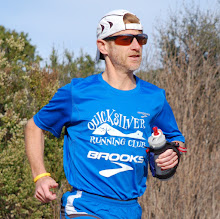For a change, not a race or run report, yet a post which has a lot to do with running. Those who follow my blog regularly might remember my support and high consideration of POST. POST stands for Peninsula Open Space Trust, a non-profit organization whose mission is to protect the green capital of the Bay Area by purchasing land before transferring it to local parks (I simplify). The year I started this blog, I posted about the 30th anniversary in 2007 then, the 35th and 40th (and this year marks 45 already!).
The night following Quicksilver 100K (long race report!), IBM was one of the sponsors of an evening with Dr. Robin Wall Kimmerer both a professor of environmental biology at SUNY and a member of the Citizen Potawatomi Nation.
I'm really glad IBM got to connect and support POST. I have an office at our Silicon Valley Lab (SVL) which, on Bailey Avenue, is far South of San Jose. When inviting clients to visit our Customer Briefing Center, we sometimes use the expression, in the middle of nowhere. But not any nowhere: besides our pride of having initiated the data revolution with the invention of the hard drive here, we actually are right in the middle of Coyote Valley which is a unique corridor for wildlife to ram between the Santa Cruz Mountains and the Diablo range (and miles beyond!). Restoring a safe corridor across this valley which was earmarked by the city of San Jose for office development, is one of POST's highest priorities and dedicated programs. (Important to note that the city of San Jose agreed to revert on these development plans and has committed to a long term and historic preservation collaboration with POST and the Santa Clara Valley Open Space Authority.)
Speaking of the Diablo range, there is a very special trail linking Fremont to Del Valle, the Ohlone Wilderness Trail. Special because it has been the course of the challenging Ohlone 50K since 1987 (36 years minus a few cancellations due to either weather/trail conditions, or a certain pandemic). Special because I ran the race 12 times including 6 overall wins and 4 other podiums (quite a few posts on my blog). Special because I had always felt some unique inspiration and connection with the Ohlone spirit at that race without realizing there were still tribe members in the area. Of course I had seen maps from the past like this one showing the large number of tribes as well as the adjacent Miwok culture, which has a 100K race named after it as well. (Credit: By Noahedits - Own work, CC BY-SA 4.0, https://commons.wikimedia.org/w/index.php?curid=83967945). But that just looked like a page of a history book without much existence left today.
I had seen a mention of the Muwekma Ohlone Tribe in the event invitation and was excited to have an opportunity to learn more about their current status and work toward reclaiming and regaining access to the land so critical to their culture, a cilture which has been so deeply connected to our area, before the colonization, the agricultural development of the Valley of the Heart's Delights, then the industrialization and development of what is known around the world as our Silicon Valley. Little did I realize that half the event was going to focus on this community, what a blessing!
This Muwekma Ohlone tribe was represented that evening by at least three generations. Its Preservation Foundation is 600-strong, down from an estimated 10 to 20,000 when the Spanish missionaries arrived in the area in 1769. They told us about the importance of land to keep their traditions alive, they even spoke to us in their native language. About the challenges of preserving or reviving their traditions in a place which became so overprice and their original land being taken away from them.
Look at this chart presented by Dr. Wall Kimmerer showing how the European wiped the Native Americans from their sacred habitat. When a picture is worth way more than a thousand words... (You figured out that green is the land owned by Indians and the dates are 1775, 1850, 1894 and 1992.)
My notes about Dr. Wall Kimmerer's speech can't make justice to a life dedicated to the sensitive topic of land equality and land justice. Please refer to her books:
- Braiding Sweetgrass: Indigenous Wisdom, Scientific Knowledge and the Teachings of Plants (with Spanish, Catalan, French and Italian translations available)
- Gathering Moss: A Natural and Cultural History of Mosses
Below are a few notes and quotes then, for those who couldn't attend either at the sold-out venue, the Cal Theater of San Jose, or online among more than 2,000 other attendees. I also took a few snapshots from the presentation, see at the bottom of the post. (I had initially included in my post a link to a YouTube recording but it has been made private since.)
- To set the mood and also using some Native American language from the Great Lakes area, Dr. Wall Kimmerer express gratitude, and what we should have gratitude for as well.
- "People are healthy when the land is healthy, not healthy when the land is not healthy."
- To challenge our Western views, she shared the vision which have allowed tribes to live in harmony for so many centuries before Caucasians invaded North America: "Earth is like a single dish, with only one spoon"; not a big spoon for some and small one for others; and everybody shares the same dish; this is the fundamental view leading to land justice.
- Everybody has gifts and responsibilities, we all have. They are 2 sides of the same coin Up to use to create land justice. Gifts can include wealth and money, time, knowledge, caring, or land...
- Our opportunity is to combine indigenous and western sciences. How do we learn from both eyes or optics. Bio diversity + knowledge diversity.
- And a big warning regarding human exceptionalism and white exceptionalism, by failing to recognize and accept the differences. We need to care about all, like birds and people, not one or the other. So more human citizens can live! As well as non-human relatives.
- Reference to the work done by terralingua.org. Notable how highly correlated biodiversity and indigenous life are (biodiversity increasing where indigenous are in charge of the land, or vice versa).
- The critical importance of TEK: Traditional Ecological Knowledge. When high tech meets high TEK! ;-) (See articles like in/from YaleEnvironment360, National Park Service, OxfordAcademic's BioScience)
- There is value in leveraging the Western materialistic and objective lens, as long as it is combined with the other lens.
- Land justice is requiring reciprocity and healing the damage, toward restorative justice (see the #LandBack movement).
- The concepts of Re-story-ation, the importance of ceremony, reciprocal restoration (have you noticed how many National Parks start with the settlers point of view as opposed to the original indigenous history and background; one reason why it's critical to restore original names of lands and places).
Overall, Dr. Wall Kimmerer reminded us that we, too, were going to be the ancestors of the next generations, that all lands become ancestral lands, asking the question: "What kind of ancestors do We want to be?"
The presentation was followed by a round table including the leaders of the Muwekma Ohlone Tribe: Charlene Nijmeh, Chairwoman (bio) and Monica Arellano, Vice Chairwoman (bio).
And a moving plea and calls to action to us all:
- Showing support for the Muwekma Ohlone recognition by co-signing this open letter (very straightforward);
- Showing support for the SJR 13 currently on the California Senate floor (easy, just need to create an account to submit to the State Legislature);
- Like the Muwekma page on Facebook (just one click!);
- Financial donations always welcome of course to the Muwekma (GoFundMe) and POST (with IBM matching IBMers' gifts)!
PS: here are a few screen shots, sorry to the parallax; not a fan at all on a flight but next time I need to get a middle seat! ;-)
























.jpg )

No comments:
Post a Comment